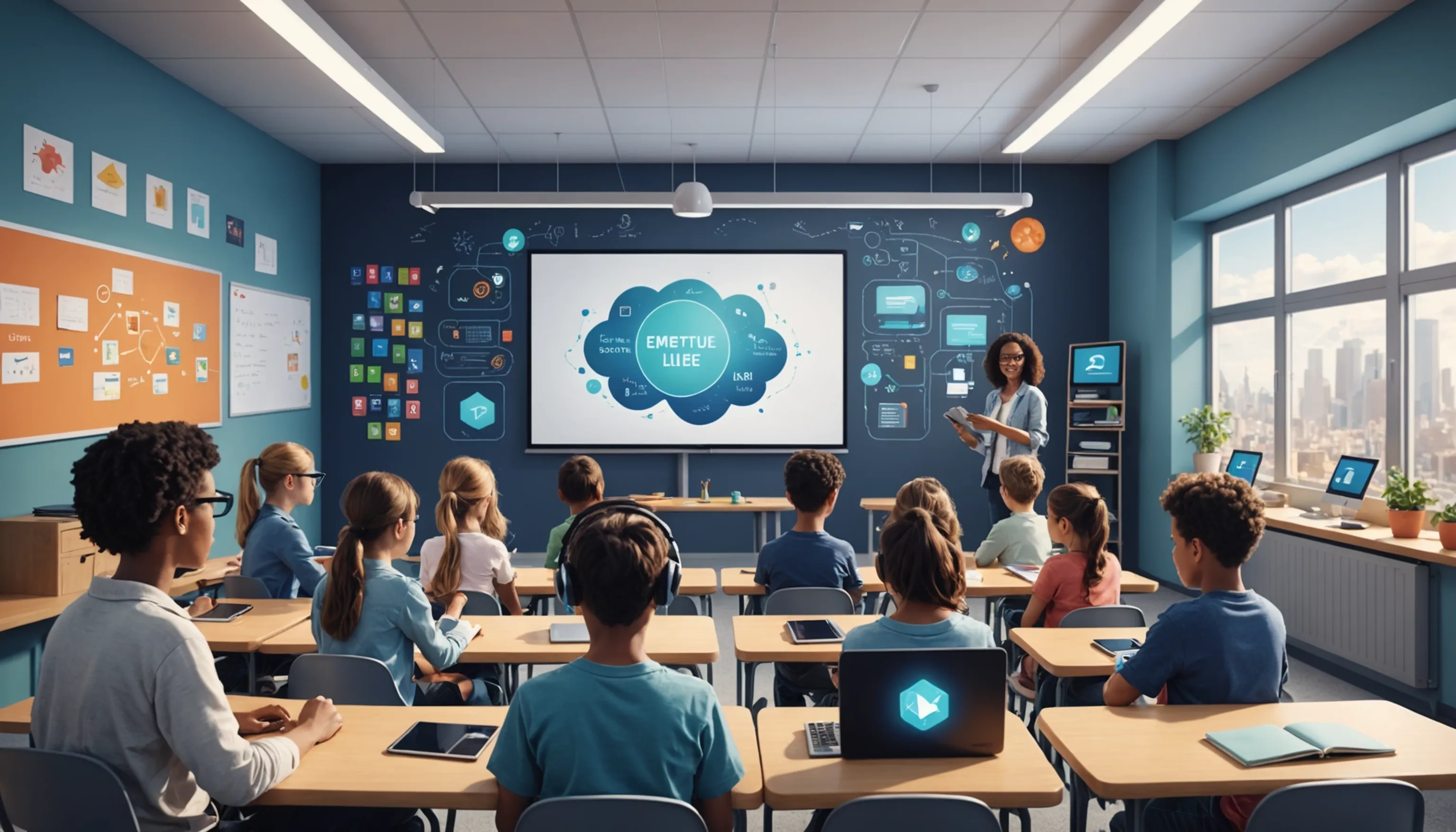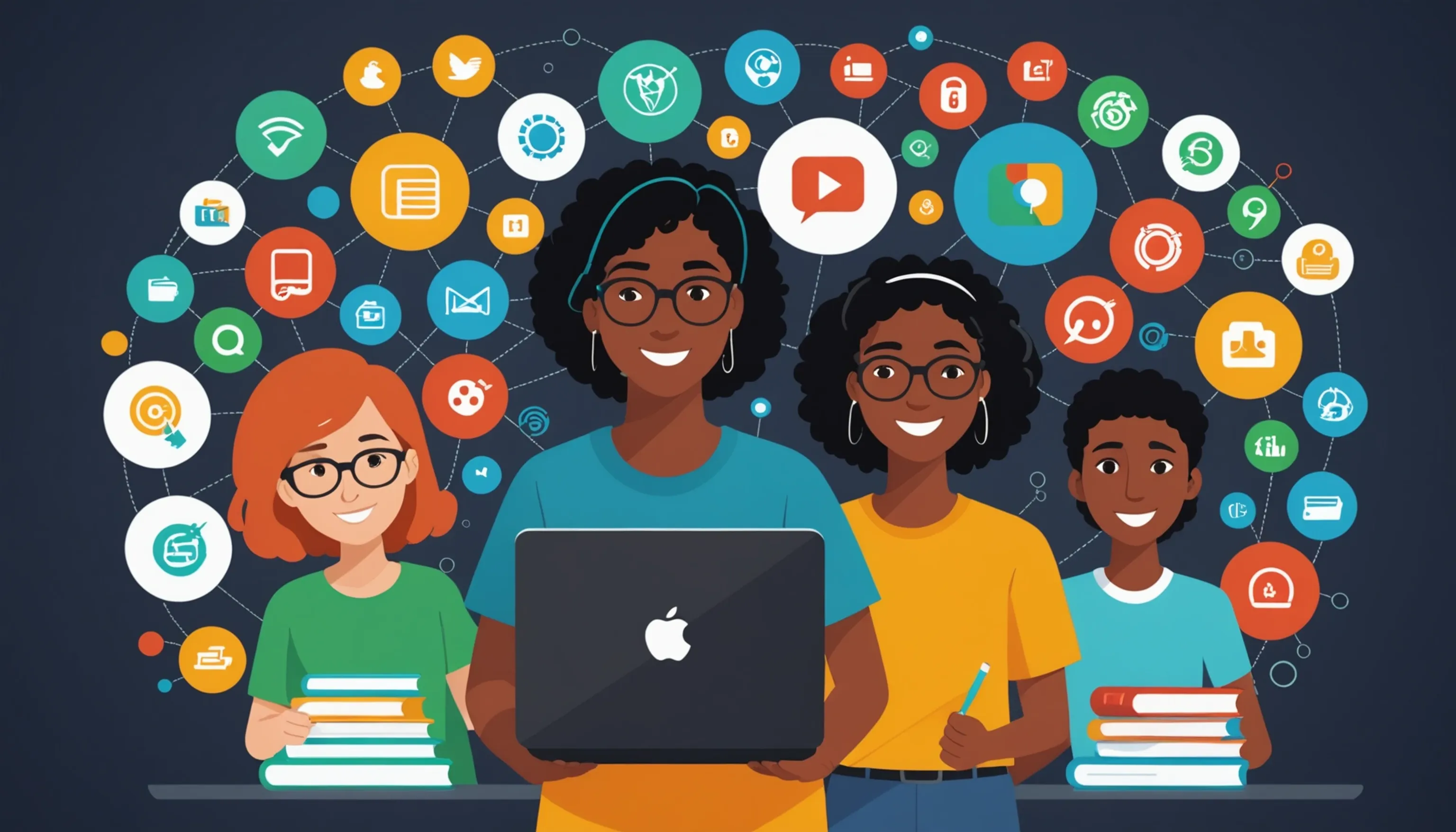The Future of Online Learning Platforms
 HvWHenry van Wagenberg
HvWHenry van Wagenberg
The Future of Online Learning Platforms
The future of online learning platforms looks promising, driven by rapid technological advancements and changing educational needs. As traditional classrooms evolve, online platforms are becoming more integral to education, particularly for teenagers. Innovations in artificial intelligence and virtual reality are set to enhance the learning experience, making it more engaging and interactive.
Platforms are focusing on personalized learning experiences, allowing students to learn at their own pace and style. This shift not only caters to diverse learning needs but also prepares students for a more digital world, fostering essential digital skills for their future careers.
Trends Shaping Online Learning
Several key trends shaping online learning are influencing how education is delivered and experienced, especially for teenagers. First, the integration of artificial intelligence (AI) is revolutionizing the learning landscape. AI-powered tools can analyze student performance, providing insights that help educators tailor their teaching methods to meet individual needs.
Another significant trend is the rise of gamification. By incorporating game-like elements into educational content, platforms can enhance student engagement and motivation. This approach makes learning more enjoyable and encourages teenagers to immerse themselves in the material.
Moreover, the demand for microlearning is increasing. Short, focused learning sessions allow students to absorb information quickly and effectively, making it easier to fit learning into busy schedules. This trend aligns well with the attention spans of today’s youth, who often prefer bite-sized content.
Additionally, there is a growing emphasis on collaborative learning. Online platforms are creating spaces for students to work together, fostering teamwork and communication skills essential for their future. This trend is particularly valuable in helping teenagers develop social connections and learn from their peers.
Lastly, the focus on diversity and inclusivity in online education ensures that all students, regardless of their background, have access to quality resources and learning opportunities. By embracing these trends, online learning platforms are poised to create more effective and engaging educational experiences for teenagers.
The Role of Artificial Intelligence in Education
The role of artificial intelligence (AI) in education is becoming increasingly significant, transforming the way students learn and educators teach. AI technologies are being integrated into online learning platforms to personalize educational experiences for teenagers. By analyzing vast amounts of data, AI can identify individual learning styles, strengths, and weaknesses, enabling tailored learning paths that cater to each student's unique needs.
One of the most notable applications of AI in education is through intelligent tutoring systems. These systems provide real-time feedback, guiding students through complex problems and adapting to their skill levels. This ensures that learners remain engaged and supported throughout their educational journey.
AI also plays a crucial role in automating administrative tasks, allowing teachers to focus more on instruction and student interaction. Tasks such as grading assignments and tracking student progress can be streamlined, leading to a more efficient learning environment.
Furthermore, AI-powered analytics can help educators identify at-risk students by monitoring their engagement and performance data. Early intervention can then be implemented to provide additional support, ensuring that no student falls behind.
Moreover, AI facilitates the creation of immersive learning experiences through technologies like virtual reality (VR) and augmented reality (AR). These tools can transport students to different environments, making learning more interactive and enjoyable.
In summary, the integration of AI in education is reshaping the landscape, offering personalized, efficient, and engaging learning experiences that are essential for preparing teenagers for the future.

Personalized Learning Experiences
Personalized learning experiences are rapidly becoming a cornerstone of modern education, especially for teenagers navigating the complexities of online learning. This approach recognizes that each student has unique needs, preferences, and learning paces, making it essential to tailor educational experiences accordingly.
One of the main benefits of personalized learning is the ability to adapt content to suit individual learning styles. For instance, some students may grasp concepts better through visual aids, while others might benefit from hands-on activities or auditory resources. Online learning platforms leverage data analytics to assess these preferences, allowing educators to curate customized learning paths.
Moreover, personalized learning encourages greater student autonomy. Teenagers can take charge of their education by selecting topics that interest them and determining the pace at which they wish to learn. This self-directed approach fosters motivation and engagement, leading to improved learning outcomes.
Another significant aspect is the use of adaptive learning technologies. These tools adjust the difficulty of tasks based on student performance in real-time, ensuring that learners are continually challenged without becoming overwhelmed. This dynamic feedback loop supports mastery of concepts and helps build confidence.
In addition, personalized learning experiences can also incorporate regular assessments and feedback, guiding students to reflect on their progress. This ongoing evaluation helps them set achievable goals and understand their strengths and areas for improvement.
Ultimately, personalized learning experiences empower teenagers, making education more relevant and effective, and preparing them for future challenges.
Benefits of Online Learning for Teenagers
Online learning offers numerous benefits for teenagers, making education more accessible and engaging. One major advantage is flexibility; students can learn at their own pace and choose their study times, accommodating busy schedules and personal preferences.
Additionally, online platforms provide access to a wide range of resources, including interactive content and multimedia tools that cater to different learning styles. This variety helps maintain interest and motivation.
Moreover, online learning fosters the development of essential digital skills, preparing teenagers for a technology-driven world. Overall, it creates a more personalized and effective learning experience.
Flexibility and Convenience
Flexibility and convenience are two of the most significant advantages of online learning, particularly for teenagers. Traditional classroom settings often impose rigid schedules and locations, which can be challenging for students juggling various commitments, such as extracurricular activities, part-time jobs, and family obligations. Online learning platforms remove these barriers by allowing students to access educational content anytime and anywhere.
This flexibility empowers teenagers to take control of their learning journey. They can choose to study during their most productive hours, whether that’s early in the morning or late at night. This self-directed approach not only boosts motivation but also helps students develop essential time management skills, preparing them for future academic and professional pursuits.
Moreover, online learning offers the convenience of customizing learning environments. Students can create spaces that suit their individual preferences, whether that’s a quiet corner at home or a local café. This personalization enhances focus and comfort, leading to a more effective learning experience.
Additionally, online platforms often provide access to a wealth of resources, including recorded lectures, interactive modules, and discussion forums, allowing teenagers to revisit materials as needed. This on-demand access ensures that students can grasp complex concepts at their own pace, significantly reducing stress associated with keeping up in a traditional classroom.
In summary, the flexibility and convenience of online learning significantly enhance the educational experience for teenagers, making it more adaptable to their unique lifestyles and learning preferences.

Access to Diverse Resources
One of the most notable benefits of online learning for teenagers is the access to diverse resources. Unlike traditional classrooms, which may be limited by physical materials, online platforms provide a wealth of information and tools that cater to various learning styles and preferences. Here are some key aspects:
- Variety of Formats: Online learning resources come in multiple formats, including videos, podcasts, interactive quizzes, and e-books. This variety allows students to engage with content in a way that suits their learning style.
- Global Perspectives: Online platforms often feature content from educators and experts worldwide. This exposure to different viewpoints and cultures enriches the learning experience, broadening students' horizons.
- Up-to-Date Information: The digital nature of online learning allows for real-time updates to materials. Students can access the latest research, trends, and developments in their fields of interest, ensuring they receive current knowledge.
- Supplementary Materials: Many online courses offer additional resources, such as forums, study groups, and mentorship opportunities. These resources provide extra support and foster collaboration among peers.
Moreover, the ease of accessing these resources encourages teenagers to explore subjects beyond their standard curriculum. This exploration can lead to a deeper understanding of interests and potential career paths.
In conclusion, the access to diverse resources in online learning not only enhances educational experiences but also equips teenagers with the tools they need to succeed in an increasingly complex world.
Development of Digital Skills
The development of digital skills is a crucial benefit of online learning for teenagers, as the modern world increasingly relies on technology. As students navigate online platforms, they acquire essential skills that will serve them well in both academic and professional settings. Here are several key aspects of this development:
- Technical Proficiency: Engaging with various online tools, such as learning management systems, video conferencing software, and educational apps, helps teenagers become proficient in using technology. These skills are vital in today's job market, where digital literacy is often a requirement.
- Research Skills: Online learning encourages students to conduct research using digital resources. They learn how to evaluate the credibility of sources, which is essential for academic writing and informed decision-making.
- Collaboration and Communication: Many online learning platforms incorporate collaborative projects, allowing students to work with peers from different locations. This experience helps them develop effective communication skills and the ability to collaborate in virtual environments.
- Problem-Solving and Critical Thinking: Online courses often present challenges that require students to think critically and solve problems independently. This fosters a growth mindset, encouraging them to tackle issues with creativity and resilience.
Furthermore, as students become more comfortable with technology, they are better prepared for future careers, which increasingly demand advanced digital skills. In summary, the development of digital skills through online learning is essential for equipping teenagers with the tools they need to thrive in a tech-driven world.
Challenges Facing Online Learning Platforms
While online learning platforms offer numerous benefits, they also face several challenges. One major issue is maintaining student engagement and motivation. Without the physical presence of teachers and peers, teenagers may struggle to stay focused and committed to their studies.
Additionally, ensuring the quality and credibility of online courses is crucial. With a plethora of content available, it can be challenging to verify the accuracy and reliability of information.
Finally, addressing the digital divide is essential, as not all students have equal access to technology and reliable internet, which can hinder their learning experience.
Maintaining Engagement and Motivation
One of the primary challenges facing online learning platforms is maintaining student engagement and motivation. Unlike traditional classrooms, where face-to-face interactions and a structured environment can foster accountability, online learning often lacks these elements. Here are several key factors contributing to this challenge:
- Isolation: Many teenagers may feel isolated when learning online, missing the social interactions that come with being in a physical classroom. This sense of isolation can lead to decreased motivation and engagement.
- Distractions: The home environment can be filled with distractions, such as smartphones, television, and household chores. These distractions make it difficult for students to focus on their studies, leading to procrastination and disengagement.
- Varied Learning Styles: Not all students thrive in an online learning format. Some may require hands-on experiences or face-to-face interactions to fully grasp concepts, making it crucial for platforms to cater to different learning styles.
- Lack of Immediate Feedback: In traditional classrooms, teachers can provide immediate feedback, helping students stay on track. Online learning may involve delays in feedback, which can hinder motivation and progress.
To combat these challenges, online learning platforms can implement strategies such as interactive content, gamification, and regular check-ins to foster a sense of community and keep students engaged. Additionally, providing opportunities for collaboration and peer interaction can help students feel more connected and motivated.
Ultimately, addressing these engagement issues is essential for the success of online learning and the educational experience of teenagers.
Ensuring Quality and Credibility
Ensuring the quality and credibility of online learning platforms is a significant challenge that affects both educators and students. With a vast array of courses and resources available, it is essential to maintain high standards to ensure effective learning experiences. Here are some key considerations:
- Course Accreditation: Accreditation by recognized organizations is crucial in establishing the credibility of online courses. Students should seek programs that have been accredited to ensure they receive quality education that is recognized by employers and educational institutions.
- Instructor Qualifications: The expertise and qualifications of instructors play a vital role in the quality of online education. Platforms must ensure that their educators possess the necessary credentials and experience to teach their subjects effectively.
- Course Content Quality: The materials used in online courses should be up-to-date, relevant, and well-structured. Regular reviews and updates are necessary to maintain the integrity and accuracy of the information provided.
- Student Feedback and Reviews: Platforms should encourage students to provide feedback on their courses. This input is invaluable for identifying areas for improvement and enhancing the overall quality of the learning experience.
Additionally, transparency about course objectives, outcomes, and assessments can help build trust among students. By clearly outlining what learners can expect, platforms can foster a sense of reliability.
Ultimately, addressing quality and credibility is essential for the success of online learning, as it ensures that students receive a valuable education that prepares them for future challenges.
Addressing Digital Divide Issues
Addressing digital divide issues is a critical challenge facing online learning platforms, particularly as education increasingly shifts to digital formats. The digital divide refers to the gap between those who have easy access to technology and the internet and those who do not. This disparity can significantly impact students' learning experiences, particularly for teenagers. Here are some key aspects to consider:
- Access to Technology: Not all students have access to the devices necessary for online learning, such as laptops, tablets, or smartphones. Schools and educational organizations must work to provide these resources, especially to students from low-income backgrounds.
- Reliable Internet Connectivity: A stable internet connection is essential for effective online learning. However, many students in rural or underserved urban areas face connectivity issues. Initiatives to improve internet infrastructure and provide affordable access options are crucial.
- Digital Literacy: Even with access to technology, some students may lack the skills needed to navigate online learning platforms effectively. Educational programs that promote digital literacy can empower students to utilize technology confidently.
- Support and Resources: Online learning platforms should offer support services, such as technical assistance and tutorials, to help students overcome challenges related to technology use.
By recognizing and addressing digital divide issues, online learning platforms can create a more equitable educational environment. Ensuring that all students have the necessary tools and support is essential for fostering successful learning experiences in the digital age.
